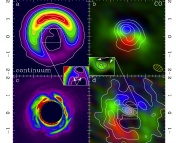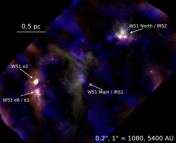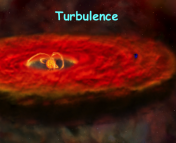- Title: Global collapse of molecular clouds as a formation mechanism for the most massive stars
- Authors: N. Peretto, G.A. Fuller, A. Duarte-Cabral, A. Avison, P. Hennebelle, J.E. Pineda, Ph. Andre, S. Bontemps, F. Motte, N. Schneider, S. Molinari
- First Author’s Institution: Laboratoire AIM, CEA/DSM-CNRS-Universite Paris Diderot, IRFU/Service d’Astrophysique, C.E. Saclay, France
The formation of massive stars is still an intense topic of debate. Two theories currently stand. The first theory predicts that molecular clouds undergo fragmentation, forming compact cores, which subsequently accumulate in mass. The second theory predicts that molecular clouds undergo global collapse, gathering matter from large scales much more rapidly. The first theory takes place slowly over time, whereas the second theory takes place ‘instantaneously.’
Observations are difficult because massive star forming regions are heavily obscured by dust – invisible in the optical and near infrared. The trick is to look at much longer wavelengths. Today’s paper does just that, using the Atacama Large Millimeter Array (ALMA) in Chile to observe the birth of a massive star in submillimeter wavelengths. At 500 times the mass of the Sun and 1 million times brighter, it is the largest forming protostar ever seen in our galaxy.
The star-forming core in question lies at the center of the infrared dark cloud SDC335.579-0.292. Oh astronomers and their naming schemes! Such clouds appear dark in comparison to the bright (infrared bright, that is) galactic plane. At 3.25 kpc from the Sun, little gas has been ionized in this star-forming core. Since massive O stars reach temperatures so hot they ionize their outer atmospheres, this ensures that the cloud is relatively young, with no massive stars yet formed.
Peretto et al. used publicly available data from the Spitzer Space Telescope, as well as the Herschel Space Observatory. They then observed the infrared dark cloud with ALMA in Chile – the most powerful radio telescope in the world.
Observations revealed a network of six filaments leading to much brighter sources in the center of the cloud – central star forming cores. Along these filaments, matter is being pulled into the central core. We are seeing massive stars at the beginning of their formation!

a.) Mid-infrared Spitzer image. The yellow dashed lines represent the 6 filaments leading in to the two central cores (marked with black crosses). b.) Herschel column density. The filaments and the cores are presented in the same manner as in a. c.) ALMA 3.2 mm dust continuum emission. The yellow ellipse represents ALMA’s beam size.
Both cores, so-called MM1 and MM2, are 0.054 pc and 0.057 pc in diameter, respectively. Their inferred core masses are 545 and 65 solar masses, respectively. MM1 is the most massive, compact protostellar core ever observed in the Galaxy. It is likely to be an O-type star progenitor. In addition to both cores, a 1000 solar mass cluster should emerge with approximately 320 total stars. Thus, an OB cluster similar to the Trapezium cluster in Orion is likely to be in the early stages of formation.
The team determined two scenarios in which MM1 is likely to have formed. 1.) the material was initially part of a much larger volume that then collapsed to form the volume we observe today. 2.) the material currently lying in MM1 initially had the same diameter as observed today. It then accreted mass from its surroundings over time.
Both of these scenarios require large-scale – as opposed to local – collapse to form MM1. The cloud core begins to collapse inwards, forming the massive protostar, while at the same time the surrounding gas cloud collapses on a larger scale with the inflowing gas rushing inward (at a rate of 0.4 km/s) along the filaments.
“It is always adventurous to draw general conclusions based on a single example,” explains Peretto in the paper. While this is the most massive star we have yet to see form, there are several other sources that hint at massive star formation. All of which suggest that large-scale infall plays a major role in building massive stars.




